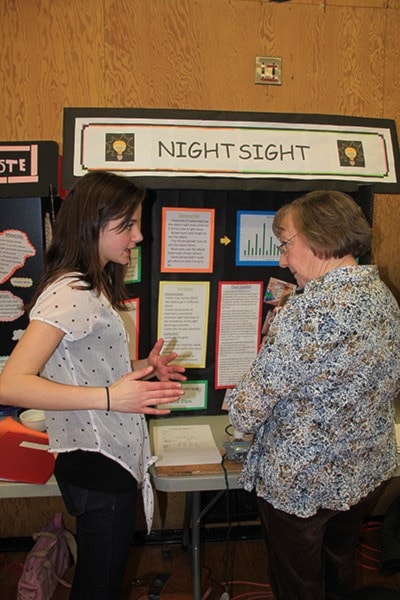Science fair season has come and gone, with several South Cariboo students succeeding in advancing from their individual school fairs, all the way to regionals, which took place at the Thompson Rivers University campus in Kamloops, April 3-5.
Projects were detailed, imaginative and thought-provoking, and a notch above projects of the past.
With an endless highway of information on the Internet available to anyone, expectations from teachers and students have risen, and the results can be mind-boggling.
Preparing children as science fair competitors comes early at 100 Mile House Elementary School where kindergarten classes are given the opportunity to tour each fair hosted by their school.
"They kind of see it as part of the school environment," says teacher Jim Price who heads up the science fair each year at 100 Mile Elementary and has been involved with it for more than 25 years.
Students are allowed to enter projects when they reach Grade 4, and Price says the buzz generally starts in late fall.
He hands out notes to students on science fair project procedure, shows them a simple project as an example and pushes them to use technology to its fullest in gathering and presenting their information.
Often, the results are amazing.
"Lots of projects are at a different focus than before. They're doing things that kids 20 years ago wouldn't have thought about. Judges are saying they're being put to the test."
A science fair project must involve an experiment or an innovation and use the scientific method as its procedure. Projects are judged, and students interviewed by professionals from the community, first at the school level, and then at the district level for those chosen to move ahead.
The next step is regionals, and this year, eight entries from 100 Mile Elementary were chosen to compete. Two each from Horse Lake Elementary School and 100 Mile House Junior Secondary were also chosen.
Had any succeeded in moving on, nationals would have been the next competition, but only five of the 180 entries at regionals were allowed to proceed.
Price says making it to regionals is a huge accomplishment, and this year, 100 Mile Elementary had more of its students qualify than any other school represented at the fair.
Participation levels in science fair over the years have seen their ups-and-downs, Price says, adding he has noticed a renewed interest developing. Schools, which haven't participated in the past few years, are coming back on board and he is happy about it.
"Doing science fair projects will help students throughout their lives and in their science classes. They've learned the basic scientific process steps and how to work with deadlines."
Darbie Barnbrook is a Grade 6 student at 100 Mile Elementary who made it to regionals with her project, Night Sight, which set out to determine if eye colour affects night vision.
She followed correct procedure and made sure she knew her project inside-out before judging day. A few changes were made based on suggestions made by judges at the district fair, and all that was left to deal with were nerves.
The outcome for her was a silver medal and a wealth of knowledge for next year's project.
"I was very impressed in Kamloops and had a lot of competition. The other projects were so advanced and gave me ideas of what to expect later."
Lucas Barton, in Grade 4 French immersion, and Conner Giroux in Grade 5 French immersion teamed up to test where bacteria accumulated most in their school.
They used supplies from the hospital to conduct their experiment, which involved swabbing targeted areas, and from the samples, growing bacteria in Petri dishes.
They weren't surprised to find the greatest amount of bacteria was found on a toilet seat. A computer keyboard was second, contrary to their hypothesis that it would be a fridge handle.
Lucas says judges at regionals asked them some tough questions, which really made them think hard for answers.
Their young minds were also put to the test during a number of extra activities at regionals, which included building a roller coaster and a crane out of recycled materials and learning how to build a simple rocket.
Science fair is one of the most exciting times of the year for Curtis who says he already has a project in the works for next year. He'll be using ideas and knowledge he came across while attending this year's fairs.
Hayley Bishop and Amber Allan, both in Grade 7 at Horse Lake Elementary, qualified for regionals with their project, Crazy Colour Confusion.
Their project goal was to determine if the colour of food affected its taste, testing if people assume flavour of food and drinks is based on the colour of the product.
While South Cariboo students competing at regionals did not qualify for nationals, several earned awards.
Competitors and their results at regionals were:
100 Mile House Elementary School
Silver: Darbie Barnbrook; Darlyssa Chretien; Ashley Holyk and Alora Pettman; and Lucas Barton and Conner Giroux.
Bronze: Calvin McEachern; Courtney Cave; and Lydia Kinasewich and Anya Levermann.
Merit: Lauren McLean and Addie Cleave.
Horse Lake Elementary School
Bronze: Hayley Bishop and Amber Allan.
Participant: Sienna Parent and Ethan Stuckel.
100 Mile House Junior Secondary
Silver: Leanne Varney.
Merit: Anna Betuzzi and Adele Halper.
District science fair results
100 Mile House Elementary School
Gold: Cave, McLean and Cleave; Paterson and Chretien, along with silver overall; and Barnbrook, silver overall.
Silver: McEachern; Pettman and Holyk; and Wylon Hall.
Bronze: Giroux and Barton.
Horse Lake Elementary School
Gold: Alex Buurmeester and Kolton Allwood.
Bronze: Bishop and Allan; and Stuckel and Parent.
100 Mile House Junior Secondary School
Gold: Halper and Betuzzi, bronze overall; and Varney, bronze overall.
